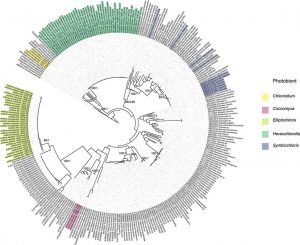 Complementing the study of the diversity of lichenized fungi of the Lobariaceae, is the study by Lindgren et al. exploring the patterns in the association in the two symbionts.
Complementing the study of the diversity of lichenized fungi of the Lobariaceae, is the study by Lindgren et al. exploring the patterns in the association in the two symbionts.
Lindgren H., B. Moncada, R. Lücking, N. Magain, A. Simon, B. Goffinet, E. Sérusiaux, M.P. Nelsen, J. Mercado-Díaz, T. Widhelm & T. Lumbsch. 2020. Cophylogenetic patterns in algal symbionts correlate with repeated symbiont switches during diversification and geographic expansion of lichen-forming fungi in the genus Sticta (Ascomycota, Peltigeraceae). Molecular Phylogenetics and Evolution 150: (in press). pdf Google scholar
Abstract reads: Species in the fungal genus Sticta form symbiotic associations primarily with either green algae or cyanobacteria, but tripartite associations or photosymbiodemes involving both types of photobionts occur in some species. Sticta is known to associate with green algae in the genus Symbiochloris. However, previous studies have shown that algae from other genera, such as Heveochlorella, may also be suitable partners for Sticta. We examined the diversity of green algal partners in the genus Sticta and assessed the patterns of association between the host fungus and its algal symbiont. We used multi-locus sequence data from multiple individuals collected in Australia, Cuba, Madagascar, Mauritius, New Zealand, Reunion and South America to infer phylogenies for fungal and algal partners and performed tests of congruence to assess coevolution between the partners. In addition, event-based methods were implemented to examine which cophylogenetic processes have led to the observed association patterns in Sticta and its green algal symbionts. Our results show that in addition to Symbiochloris, Sticta associates with green algae from the genera Chloroidium, Coccomyxa, Elliptochloris and Heveochlorella, the latter being the most common algal symbiont associated with Sticta in this study. Geography plays a strong role in shaping fungal-algal association patterns in Sticta as mycobionts associate with different algal lineages in different geographic locations. While fungal and algal phylogenies were mostly congruent, event-based methods did not find any evidence for cospeciation between the partners. Instead, the association patterns observed in Sticta and associated algae, were largely explained by other cophylogenetic events such as host-switches, losses of symbiont and failure of the symbiont to diverge with its host. Our results also show that tripartite associations with green algae evolved multiple times in Sticta.